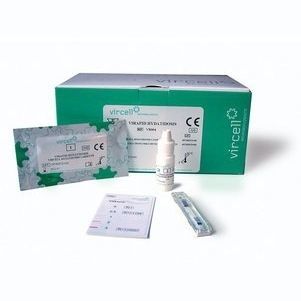
Rapid hydatidosis test VIRAPID® IgGEchinococcus granulosusserum
Add to favorites
Compare this product
Characteristics
- Applications
- for hydatidosis
- Tested parameter
- IgG
- Micro-organism
- Echinococcus granulosus
- Sample type
- serum, plasma, clinical
- Analysis mode
- immunochromatographic, ELISA, hemagglutination
- Result display time
30 min
- Specificity
99.5 %
- Sensitivity
94.7 %
Description
total antibodies against Echinococcus granulosus in serum/plasma samples.
User friendly protocol with little manipulation
All necessary reagents are included in the kit
Product control line on each device
Based on specific and highly purified antigen (conjugate and line)
General information
Imaging techniques such as ultrasound scan or X-ray are the tools usually used to diagnose hydatidosis. However, symptoms of hydatid cyst must be always confirmed by serological assay since it can be confused with other illnesses, including tumours. Cysts can be treated with chemotherapy while the treatment does not always give good results. Sometimes operation is required.
There is no specific standardized and highly sensitive serological test; so, in clinical practice the serological results depend on many factors such as quality of the antigen, technique employed, affected organ, number of hydatid cysts and variability of immune responses. Due to variable sensitivity of different tests, many laboratories usually carry out at least two different techniques for their routine diagnosis. Currently, serological confirmation is performed through a combination of several techniques. The most commonly used tests are enzyme-linked immunosorbent assays (IgG-ELISA), indirect hemagglutination (IHA) and latex agglutination (LAT).
VIRapid® HYDATIDOSIS is the first immunochromatographic test in the market for hydatidosis detection and offers important benefits for both, big and small laboratories, in prevalent areas against the techniques currently used. A HPLC-purified E. granulosus 5/B enriched antigen is used to improve the specificity of the assay while keeping a high sensitivity.
Catalogs
VIRapid Hydatidosis Brochure
2 Pages
Related Searches
- Assay kit
- Blood assay kit
- Serum assay kit
- Immunoassay assay kit
- Plasma assay kit
- Infectious disease detection kit
- Blood rapid diagnostic test
- Diagnostic reagent kit
- Laboratory reagent kit
- Rapid lateral flow test
- Immunoassay rapid diagnostic test
- Serum rapid diagnostic test
- Plasma rapid diagnostic test
- Reagent medium reagent kit
- Infectious disease rapid diagnostic test
- ELISA assay kit
- Clinical reagent kit
- Virus reagent kit
- IgG test kit
- Clinical rapid diagnostic test
*Prices are pre-tax. They exclude delivery charges and customs duties and do not include additional charges for installation or activation options. Prices are indicative only and may vary by country, with changes to the cost of raw materials and exchange rates.


